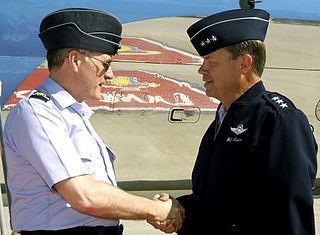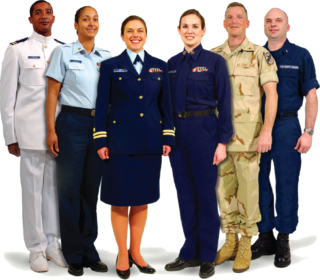The United States has eight federal uniformed services that commission officers as defined by Title 10 and subsequently structured and organized by Titles 10, 14, 32, 33, and 42 of the U.S. Code.

The National Oceanic and Atmospheric Administration Commissioned Officer Corps, known informally as the NOAA Corps, is one of eight federal uniformed services of the United States, and operates under the National Oceanic and Atmospheric Administration (NOAA), a scientific agency overseen by the Department of Commerce. The NOAA Corps is made up of scientifically and technically trained officers. The NOAA Corps and the United States Public Health Service Commissioned Corps are the only U.S. uniformed services that consist only of commissioned officers, with no enlisted or warrant officer ranks. The NOAA Corps' primary mission is to monitor oceanic conditions, support major waterways, and monitor atmospheric conditions.

A service stripe is an embroidered diagonal stripe worn on the sleeve(s) of some military and paramilitary uniforms. In the case of the United States military, service stripes are authorized for wear by enlisted personnel on the lower part of the sleeve of a uniform to denote length of service. Service stripes vary in size and in color.

The diver insignia are qualification badges of the uniformed services of the United States which are awarded to servicemen qualified as divers. Originally, the diver insignia was a cloth patch decoration worn by United States Navy divers in the upper-portion of the enlisted service uniform's left sleeve during the first part of World War II, when the rating insignia was worn on the right sleeve. When enlisted rating insignia were shifted to the left sleeve in late World War II, the patch shifted to the upper right sleeve. The diving patch was created during World War II, and became a breast insignia in the late 1960s.

Mess dress uniform is the most formal type of evening-wear uniform used by military personnel, police personnel, and other uniformed services members. It frequently consists of a mess jacket, trousers, white dress shirt and a black bow tie, along with orders and medals insignia. Design may depend on regiment or service branch, e.g. army, navy, air force, marines, etc. In modern Western dress codes, mess dress uniform is the supplementary alternative equivalent to the civilian black tie for evening wear. Mess dress uniforms are typically less formal than full dress uniform, but more formal than service dress uniform.

A side cap is a military cap that can be folded flat when not being worn. It is also known as a garrison cap or flight cap in the United States, wedge cap in Canada, or field service cap in the United Kingdom; or in vulgar slang as a cunt cap. In form the side cap is comparable to the glengarry, a folding version of the Scottish military bonnet. It has been associated with various military forces since the middle of the 19th century, as well as various civilian organizations.

A peaked cap, peaked hat, service cap, barracks cover, or combination cap is a form of headgear worn by the armed forces of many nations, as well as many uniformed civilian organisations such as law enforcement agencies and fire departments. It derives its name from its short visor, or peak, which was historically made of polished leather but increasingly is made of a cheaper synthetic substitute.

The black beret is a colour of beret, a type of headgear. It is commonly worn by paramilitaries and militaries around the world, particularly armored forces such as the British Army's Royal Tank Regiment (RTR), the Royal Canadian Armoured Corps (RCAC), and Royal Australian Armoured Corps (RAAC) and the Indian Army Armoured Corps and Indian Border Security Force. Notable non-armored military units to wear the black beret include the non-military police and non-special forces elements of the Irish Defence Forces, MOD Guard Service, Russian Naval Infantry and Russian OMON units, the United States Air Force (USAF) Tactical Air Control Party (TACP), Philippine National Police-Special Action Force (PNP-SAF) members, and the Royal Canadian Navy. It was also worn by the United Kingdom's Royal Observer Corps (ROC) with their Royal Air Force (RAF) uniform, Metropolitan Manila Development Authority (MMDA).

Colonel Katherine Amelia Towle was the second director of the United States Marine Corps Women's Reserve (USMCWR) and the first director of Women Marines.

The Command at Sea insignia is a badge of the United States' seagoing services worn by officers on their uniforms to denote that they are the commander, or formerly a commander, of a warship. If the wearer is currently the commander of a warship, it is worn above the nametag, which is worn a quarter of an inch above the right chest pocket on a uniform shirt. Afterwards, the pin is moved to the left side of the shirt or jacket. For the commanders of land-based installations, a different but similar version known as the Command Ashore insignia instead.

Full dress uniform, also known as a ceremonial dress uniform or parade dress uniform, is the most formal type of uniforms used by military, police, fire and other public uniformed services for official parades, ceremonies, and receptions, including private ones such as marriages and funerals. Full dress uniforms typically include full-size orders and medals insignia. Styles tend to originate from 19th century uniforms, although the 20th century saw the adoption of mess dress-styled full-dress uniforms. Designs may depend on regiment or service branch. In Western dress codes, full dress uniform is a permitted supplementary alternative equivalent to the civilian white tie for evening wear or morning dress for day wear – sometimes collectively called full dress – although military uniforms are the same for day and evening wear. As such, full dress uniform is the most formal uniform, followed by the mess dress uniform.

The uniforms of the United States Navy include dress uniforms, daily service uniforms, working uniforms, and uniforms for special situations, which have varied throughout the history of the navy. For simplicity in this article, officers refers to both commissioned officers and warrant officers.

A physical training uniform is a military or organizational uniform used during exercise, calisthenics, drills, and in some cases, very casual periods of time. Most militaries, especially the United States Armed Forces and their auxiliaries require use of a physical training (PT) uniform during unit exercise. All items worn by military personnel conducting PT as a group are subject to uniformity, at commander discretions, however, some U.S. military units produce unique T-shirts with their unit insignia and motto, and for special events, this shirt is part of the uniform. Occasionally, exercise will also be conducted in that branch's utility uniforms, normally with the blouse removed and the undershirt exposed. For unit runs, esprit de corps or special occasions, commanders may have personnel wear unique T-shirts with the distinctive unit insignia and unit colors.

Service dress uniform is the informal type of uniform used by military, police, fire and other public uniformed services for everyday office, barracks and non-field duty purposes and sometimes for ceremonial occasions. It frequently consists of a jacket, trousers, dress shirt, and neck tie, along with orders, medals, and insignia. Design may depend on regiment or service branch, e.g. army, navy, air force, marines, etc. In Western dress codes, a service dress uniform is a permitted supplementary alternative equivalent to the civilian suit - sometimes collectively called undress or "dress clothes". As such, a service dress uniform is considered less formal than both full dress and mess dress uniforms, but more formal than combat uniforms.

The United States Marine Corps (USMC) prescribes several types of military uniform to distinguish its service members from other armed services, depending on the situation.
In the uniformed services of the United States, captain is a commissioned-officer rank. In keeping with the traditions of the militaries of most nations, the rank varies between the services, being a senior rank in the naval services and a junior rank in the ground and air forces. Many fire departments and police departments in the United States also use the rank of captain as an officer in a specific unit.

The uniforms of the United States Air Force are the standardized military uniforms worn by airmen of the United States Air Force to distinguish themselves from the other services.
The uniforms of the United States Coast Guard Auxiliary serve to distinguish Auxiliarists from members of other civilian military auxiliaries and of other armed services.

The Uniforms of the United States Coast Guard include dress uniforms, daily service uniforms, working uniforms, and uniforms for special situations, which have varied throughout the history of the USCG.
















